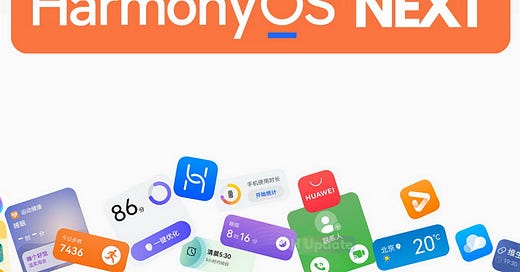HarmonyOS NEXT Use Cases (API 12+): Innovative Application Design and Practice
This article helps implement innovative applications on the HarmonyOS NEXT platform to help developers better understand the features and application scenarios of the new version.
introduction
With the release of HarmonyOS NEXT, developers are ushering in a new ecosystem of operating systems. HarmonyOS NEXT not only inherits the distributed capabilities of HarmonyOS, but also comprehensively upgrades its performance, security, and development experience. In particular, the launch of API 12 and above provides developers with more possibilities for innovative applications. In this article, we will take a closer look at how to design and implement innovative applications on the HarmonyOS NEXT platform to help developers better understand the features and application scenarios of the new version.
1. Core features of HarmonyOS NEXT
1.1 Enhancement of distributed capabilities
HarmonyOS NEXT has significantly improved its distributed capabilities, especially in terms of device collaboration, data sharing, and task flow. API 12 makes it easier for developers to achieve a seamless experience across devices. For example, users can seamlessly switch tasks between devices such as mobile phones, tablets, and smart watches, making data synchronization more efficient.
1.2 Performance optimization and resource management
HarmonyOS NEXT has done a lot of work on performance optimization, especially in resource management and scheduling. API 12 introduces a more intelligent resource scheduling mechanism, which can dynamically adjust resource allocation according to the status of the device and the needs of users, ensuring the smooth and stable operation of applications.
1.3 Security Improvements
Security has always been a key area of focus for HarmonyOS. In HarmonyOS NEXT, API 12 introduces stricter security mechanisms, including data encryption, rights management, and privacy protection. Developers can take advantage of these new features to build more secure and reliable applications.
2. Innovative application design ideas
2.1 Cross-device collaborative experience
On the HarmonyOS NEXT platform, cross-device collaboration is an important innovation direction. With API 12, developers can design apps that seamlessly switch between multiple devices. For example, users can start a task on their phone and continue on their tablet, and all data will be automatically synced. This design not only improves the user experience, but also enhances the stickiness of the app.
2.2 Intelligent Scene Perception
HarmonyOS NEXT provides powerful scene-aware capabilities, allowing developers to design apps that automatically adjust their functionality to the user's environment using the scene-aware interface in API 12. For example, when a user enters a meeting room, the app can automatically switch to silent mode and provide meeting-related features. This intelligent design can significantly improve the user experience.
2.3 Personalized Recommendations
Through the data analytics interface in API 12, developers can design applications that can make personalized recommendations based on user behavior and preferences. For example, a news app can recommend relevant articles based on a user's reading habits, and a shopping app can recommend products based on a user's purchase history. This personalized design increases user satisfaction and increases the activity of the app.
3. Practical case: smart home control application
3.1 Application Background
With the popularity of smart home devices, the demand for smart home control applications is increasing day by day. On the HarmonyOS NEXT platform, developers can leverage the distributed capabilities and scenario-aware APIs in API 12 to design smarter home control applications.
3.2 Functional Design
The app's key features include device control, scene mode, and personalized recommendations. With API 12, apps can collaborate across devices, allowing users to control smart devices in their homes from their phones, tablets, or smartwatches. In addition, the app can automatically adjust device settings based on the user's environment, such as automatically dimming the lights and playing soothing music when the user enters the bedroom.
3.3 Implementation Details
During implementation, developers can take advantage of the distributed data management interface in API 12 to ensure real-time synchronization of device status and user settings. At the same time, through the scene-aware interface, the application can automatically identify the user's environment and trigger the corresponding device control logic. In addition, developers can also use the data analysis interface to make personalized recommendations based on users' usage habits, such as recommending commonly used device settings or scene modes.
Fourth, summary and outlook
HarmonyOS NEXT provides a powerful platform for developers, especially in API 12 and above, with new features and interfaces that open up more possibilities for the design and implementation of innovative applications. Through design ideas such as cross-device collaboration, intelligent scene awareness, and personalized recommendations, developers can build more intelligent, convenient, and personalized applications, bringing new experiences to users.
In the future, as the HarmonyOS ecosystem continues to grow, we look forward to seeing more innovative applications emerge to promote the deep integration of smart devices and users' lives. Developers should continue to pay attention to the latest developments of HarmonyOS, make full use of the features and interfaces of the new version, and continue to explore and innovate to create more value for users.
References
HarmonyOS Developer Documentation, API 12+.
HarmonyOS NEXT Release Notes.
Distributed Capabilities in HarmonyOS NEXT.
Security Enhancements in HarmonyOS NEXT.
The above content is an analysis of HarmonyOS NEXT use cases, which aims to help developers better understand the features and application scenarios of the new version and design innovative applications. Hopefully, this article will provide you with a valuable reference for your development efforts.




